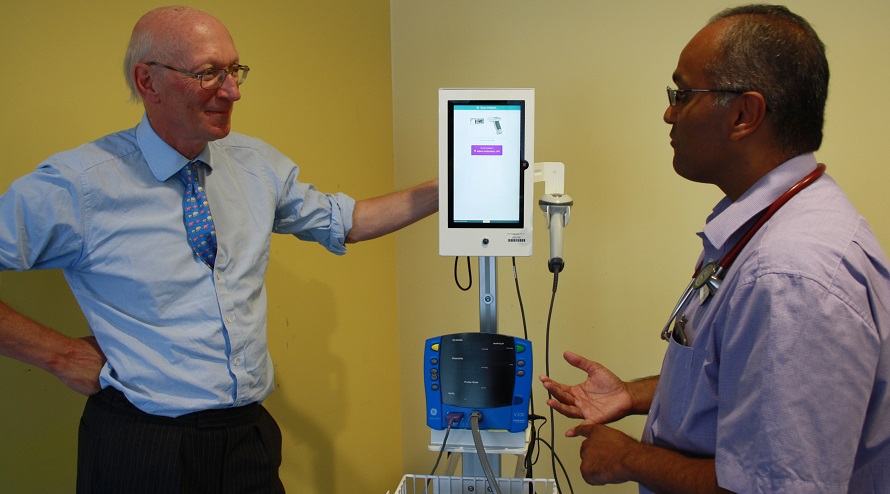
Lord Prior, Parliamentary Under Secretary of State at the Department of Health, is shown The System for Electronic Notification and Documentation (SEND) system at Oxford’s John Radcliffe Hospital by Geratology Consultant by Dr Sudhir Singh
Digital technology to improve patient care at Oxfordshire’s hospitals was showcased during a visit to the John Radcliffe Hospital (JRH) by Government Minister Lord Prior.
The Parliamentary Under Secretary of State at the Department of Health was shown a tablet computer system that is replacing bedside charts, and work that builds on this to tackle sepsis (a severe response to serious infection).
Dr Peter Watkinson, a John Radcliffe Consultant in Intensive Care Medicine, spoke about the tablet computer programme during the visit, on Wednesday, July 20.
The System for Electronic Notification and Documentation (SEND) system involves staff inputting patient vital signs such as heart rate and blood pressure into tablet computers by patients’ beds.
SEND results from a successful collaboration between Oxford University Hospitals NHS Foundation Trust and the University of Oxford’s Institute of Biomedical Engineering.
The technology has been devised and researched through the NIHR Oxford Biomedical Research Centre, a collaboration between the Trust and the University.
The tablet – which links to patient barcode wristbands to identify them – immediately provides advice on how to manage the patient’s care and clearly displays any deterioration in their condition.
It also means information about patients can be shared around the Trust, including on desktop computers, saving crucial time that was previously spent looking for and transporting paper charts.
The system has been fully introduced at the Churchill Hospital and Nuffield Orthopaedic Centre, Oxford and Banbury’s Horton General Hospital and will be rolled out at the JRH by the end of August.
Dr Andrew Brent, Consultant in Infectious Diseases & General Medicine and lead on sepsis for the Trust, described how they are using data from SEND and computerised medical records, the Electronic Patient Record (EPR), to improve management of sepsis.
Sepsis is a common and potentially life-threatening condition whereby severe infection triggers widespread inflammation and organ failure.
Using SEND and EPR the Trust has developed electronic tools to help identify sepsis cases early and start treatment promptly.
Lord Prior was able to see the whole system in action during a visit to the Trust’s Ambulatory Medicine Unit, where patients can be assessed and treated without admission to hospital.
Lord Prior said: “I was very impressed by the innovative work I saw being carried out by staff at the John Radcliffe Hospital.
“New technology developed by the hospital in conjunction with the engineering faculty at the university, such as the SEND and Electronic Patient Record systems, are playing a key role in identifying deteriorating patients and getting them the care they need more quickly.
“Unquestionably lives will be saved. I hope other NHS Hospitals will adopt SEND.”
Dr Tony Berendt, the Trust’s Medical Director, said: “These digital technologies are great examples of the Trust’s commitments to learning from research, putting innovations into practice, and raising the quality of the care we offer. We are delighted that clinical leaders at the forefront of this work were able to explain and demonstrate these important safety enhancements.”